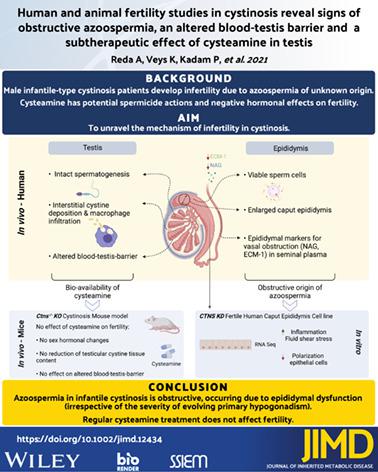当前位置:
X-MOL 学术
›
J. Inherit. Metab. Dis.
›
论文详情
Our official English website, www.x-mol.net, welcomes your
feedback! (Note: you will need to create a separate account there.)
Human and animal fertility studies in cystinosis reveal signs of obstructive azoospermia, an altered blood-testis barrier and a subtherapeutic effect of cysteamine in testis
Journal of Inherited Metabolic Disease ( IF 4.2 ) Pub Date : 2021-09-08 , DOI: 10.1002/jimd.12434 Ahmed Reda 1, 2 , Koenraad Veys 1, 3 , Prashant Kadam 2 , Anna Taranta 4 , Laura Rita Rega 4 , Bianca M Goffredo 5 , Chelsea Camps 1 , Martine Besouw 6 , Daniel Cyr 7 , Maarten Albersen 8 , Carl Spiessens 9 , Liesbeth de Wever 10 , Robert Hamer 11 , Mirian C H Janssen 12 , Kathleen D'Hauwers 12 , Alex Wetzels 12 , Leo Monnens 12 , Lambertus van den Heuvel 1, 12 , Ellen Goossens 2 , Elena Levtchenko 1, 3
Journal of Inherited Metabolic Disease ( IF 4.2 ) Pub Date : 2021-09-08 , DOI: 10.1002/jimd.12434 Ahmed Reda 1, 2 , Koenraad Veys 1, 3 , Prashant Kadam 2 , Anna Taranta 4 , Laura Rita Rega 4 , Bianca M Goffredo 5 , Chelsea Camps 1 , Martine Besouw 6 , Daniel Cyr 7 , Maarten Albersen 8 , Carl Spiessens 9 , Liesbeth de Wever 10 , Robert Hamer 11 , Mirian C H Janssen 12 , Kathleen D'Hauwers 12 , Alex Wetzels 12 , Leo Monnens 12 , Lambertus van den Heuvel 1, 12 , Ellen Goossens 2 , Elena Levtchenko 1, 3
Affiliation

|
Cystinosis is an inherited metabolic disorder caused by autosomal recessive mutations in the CTNS gene leading to lysosomal cystine accumulation. The disease primarily affects the kidneys followed by extra-renal organ involvement later in life. Azoospermia is one of the unclarified complications which are not improved by cysteamine, which is the only available disease-modifying treatment. We aimed at unraveling the origin of azoospermia in cysteamine-treated cystinosis by confirming or excluding an obstructive factor, and investigating the effect of cysteamine on fertility in the Ctns−/− mouse model compared with wild type. Azoospermia was present in the vast majority of infantile type cystinosis patients. While spermatogenesis was intact, an enlarged caput epididymis and reduced levels of seminal markers for obstruction neutral α-glucosidase (NAG) and extracellular matrix protein 1 (ECM1) pointed towards an epididymal obstruction. Histopathological examination in human and mouse testis revealed a disturbed blood-testis barrier characterized by an altered zonula occludens-1 (ZO-1) protein expression. Animal studies ruled out a negative effect of cysteamine on fertility, but showed that cystine accumulation in the testis is irresponsive to regular cysteamine treatment. We conclude that the azoospermia in infantile cystinosis is due to an obstruction related to epididymal dysfunction, irrespective of the severity of an evolving primary hypogonadism. Regular cysteamine treatment does not affect fertility but has subtherapeutic effects on cystine accumulation in testis.
中文翻译:

胱氨酸病的人类和动物生育力研究揭示了阻塞性无精子症的迹象、血睾丸屏障改变和半胱胺在睾丸中的亚治疗作用
胱氨酸病是一种遗传性代谢疾病,由CTNS基因中的常染色体隐性突变导致溶酶体胱氨酸积累引起。该疾病主要影响肾脏,随后在以后的生活中累及肾外器官。无精子症是半胱胺无法改善的未明确并发症之一,半胱胺是唯一可用的疾病缓解治疗。我们旨在通过确认或排除阻塞性因素来揭示半胱胺治疗的胱氨酸病中无精子症的起源,并研究半胱胺对Ctns生育力的影响-/-小鼠模型与野生型相比。绝大多数婴儿型胱氨酸病患者存在无精子症。虽然精子发生是完整的,但附睾头增大和阻塞中性 α-葡萄糖苷酶 (NAG) 和细胞外基质蛋白 1 (ECM1) 的精液标志物水平降低表明附睾阻塞。人类和小鼠睾丸的组织病理学检查揭示了以改变的 zonula occludens-1 (ZO-1) 蛋白表达为特征的受干扰的血睾丸屏障。动物研究排除了半胱胺对生育能力的负面影响,但表明睾丸中的胱氨酸积累对常规半胱胺治疗无反应。我们得出结论,婴儿胱氨酸病的无精子症是由于与附睾功能障碍相关的阻塞,无论演变的原发性性腺机能减退的严重程度如何。常规半胱胺治疗不会影响生育能力,但对睾丸中的胱氨酸积累具有亚治疗作用。
更新日期:2021-11-09
中文翻译:

胱氨酸病的人类和动物生育力研究揭示了阻塞性无精子症的迹象、血睾丸屏障改变和半胱胺在睾丸中的亚治疗作用
胱氨酸病是一种遗传性代谢疾病,由CTNS基因中的常染色体隐性突变导致溶酶体胱氨酸积累引起。该疾病主要影响肾脏,随后在以后的生活中累及肾外器官。无精子症是半胱胺无法改善的未明确并发症之一,半胱胺是唯一可用的疾病缓解治疗。我们旨在通过确认或排除阻塞性因素来揭示半胱胺治疗的胱氨酸病中无精子症的起源,并研究半胱胺对Ctns生育力的影响-/-小鼠模型与野生型相比。绝大多数婴儿型胱氨酸病患者存在无精子症。虽然精子发生是完整的,但附睾头增大和阻塞中性 α-葡萄糖苷酶 (NAG) 和细胞外基质蛋白 1 (ECM1) 的精液标志物水平降低表明附睾阻塞。人类和小鼠睾丸的组织病理学检查揭示了以改变的 zonula occludens-1 (ZO-1) 蛋白表达为特征的受干扰的血睾丸屏障。动物研究排除了半胱胺对生育能力的负面影响,但表明睾丸中的胱氨酸积累对常规半胱胺治疗无反应。我们得出结论,婴儿胱氨酸病的无精子症是由于与附睾功能障碍相关的阻塞,无论演变的原发性性腺机能减退的严重程度如何。常规半胱胺治疗不会影响生育能力,但对睾丸中的胱氨酸积累具有亚治疗作用。











































 京公网安备 11010802027423号
京公网安备 11010802027423号